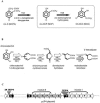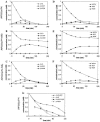Chlorophenol hydroxylases encoded by plasmid pJP4 differentially contribute to chlorophenoxyacetic acid degradation
- PMID: 16597983
- PMCID: PMC1448979
- DOI: 10.1128/AEM.72.4.2783-2792.2006
Chlorophenol hydroxylases encoded by plasmid pJP4 differentially contribute to chlorophenoxyacetic acid degradation
Abstract
Phenoxyalkanoic compounds are used worldwide as herbicides. Cupriavidus necator JMP134(pJP4) catabolizes 2,4-dichlorophenoxyacetate (2,4-D) and 4-chloro-2-methylphenoxyacetate (MCPA), using tfd functions carried on plasmid pJP4. TfdA cleaves the ether bonds of these herbicides to produce 2,4-dichlorophenol (2,4-DCP) and 4-chloro-2-methylphenol (MCP), respectively. These intermediates can be degraded by two chlorophenol hydroxylases encoded by the tfdB(I) and tfdB(II) genes to produce the respective chlorocatechols. We studied the specific contribution of each of the TfdB enzymes to the 2,4-D/MCPA degradation pathway. To accomplish this, the tfdB(I) and tfdB(II) genes were independently inactivated, and growth on each chlorophenoxyacetate and total chlorophenol hydroxylase activity were measured for the mutant strains. The phenotype of these mutants shows that both TfdB enzymes are used for growth on 2,4-D or MCPA but that TfdB(I) contributes to a significantly higher extent than TfdB(II). Both enzymes showed similar specificity profiles, with 2,4-DCP, MCP, and 4-chlorophenol being the best substrates. An accumulation of chlorophenol was found to inhibit chlorophenoxyacetate degradation, and inactivation of the tfdB genes enhanced the toxic effect of 2,4-DCP on C. necator cells. Furthermore, increased chlorophenol production by overexpression of TfdA also had a negative effect on 2,4-D degradation by C. necator JMP134 and by a different host, Burkholderia xenovorans LB400, harboring plasmid pJP4. The results of this work indicate that codification and expression of the two tfdB genes in pJP4 are important to avoid toxic accumulations of chlorophenols during phenoxyacetic acid degradation and that a balance between chlorophenol-producing and chlorophenol-consuming reactions is necessary for growth on these compounds.
Figures




Similar articles
-
Mutation analysis of the different tfd genes for degradation of chloroaromatic compounds in Ralstonia eutropha JMP134.Arch Microbiol. 2004 Feb;181(2):112-21. doi: 10.1007/s00203-003-0634-4. Epub 2003 Dec 16. Arch Microbiol. 2004. PMID: 14676989
-
Characterization of a second tfd gene cluster for chlorophenol and chlorocatechol metabolism on plasmid pJP4 in Ralstonia eutropha JMP134(pJP4).J Bacteriol. 2000 Aug;182(15):4165-72. doi: 10.1128/JB.182.15.4165-4172.2000. J Bacteriol. 2000. PMID: 10894723 Free PMC article.
-
Molecular characterization of a deletion/duplication rearrangement in tfd genes from Ralstonia eutropha JMP134(pJP4) that improves growth on 3-chlorobenzoic acid but abolishes growth on 2,4-dichlorophenoxyacetic acid.Microbiology (Reading). 2001 Aug;147(Pt 8):2141-2148. doi: 10.1099/00221287-147-8-2141. Microbiology (Reading). 2001. PMID: 11495991
-
Microbial degradation of 2,4-dichlorophenoxyacetic acid: Insight into the enzymes and catabolic genes involved, their regulation and biotechnological implications.Crit Rev Microbiol. 2016;42(2):194-208. doi: 10.3109/1040841X.2014.917068. Epub 2014 Jul 24. Crit Rev Microbiol. 2016. PMID: 25058513 Review.
-
The identification and cloning of genes encoding haloaromatic catabolic enzymes and the construction of hybrid pathways for substrate mineralization.Basic Life Sci. 1984;28:47-80. doi: 10.1007/978-1-4684-4715-6_4. Basic Life Sci. 1984. PMID: 6322743 Review.
Cited by
-
Evolutions of microbial degradation pathways for parent xenobiotic and for its metabolites follow different schemes.Environ Sci Pollut Res Int. 2012 Sep;19(8):3276-81. doi: 10.1007/s11356-012-0841-0. Epub 2012 Mar 16. Environ Sci Pollut Res Int. 2012. PMID: 22421797
-
Biochemical and Genetic Bases of Indole-3-Acetic Acid (Auxin Phytohormone) Degradation by the Plant-Growth-Promoting Rhizobacterium Paraburkholderia phytofirmans PsJN.Appl Environ Microbiol. 2016 Dec 15;83(1):e01991-16. doi: 10.1128/AEM.01991-16. Print 2017 Jan 1. Appl Environ Microbiol. 2016. PMID: 27795307 Free PMC article.
-
Hierarchy of Carbon Source Utilization in Soil Bacteria: Hegemonic Preference for Benzoate in Complex Aromatic Compound Mixtures Degraded by Cupriavidus pinatubonensis Strain JMP134.Appl Environ Microbiol. 2015 Jun 15;81(12):3914-24. doi: 10.1128/AEM.04207-14. Epub 2015 Mar 20. Appl Environ Microbiol. 2015. PMID: 25795675 Free PMC article.
-
Biodegradation of Pesticides at the Limit: Kinetics and Microbial Substrate Use at Low Concentrations.Front Microbiol. 2020 Aug 27;11:2107. doi: 10.3389/fmicb.2020.02107. eCollection 2020. Front Microbiol. 2020. PMID: 32983068 Free PMC article.
-
Diversity and Activity of Communities Inhabiting Plastic Debris in the North Pacific Gyre.mSystems. 2016 May 17;1(3):e00024-16. doi: 10.1128/mSystems.00024-16. eCollection 2016 May-Jun. mSystems. 2016. PMID: 27822538 Free PMC article.
References
-
- Ausubel, F., R. Brent, R. Kingston, D. Moore, J. Seidman, J. Smith, and K. Struhl (ed.). 1992. Short protocols in molecular biology, 2nd ed. Greene Publishing Associates, New York, N.Y.
-
- Beadle, C. A., and A. R. W. Smith. 1982. The purification and properties of 2,4-dichlorophenol hydroxylase from a strain of Acinetobacter species. Eur. J. Biochem. 123:323-332. - PubMed
-
- Clément, P., V. Matus, L. Cárdenas, and B. González. 1995. Degradation of trichlorophenols by Alcaligenes eutrophus JMP134. FEMS Microbiol. Lett. 127:51-55. - PubMed
Publication types
MeSH terms
Substances
LinkOut - more resources
Full Text Sources
Other Literature Sources
Molecular Biology Databases
Miscellaneous

